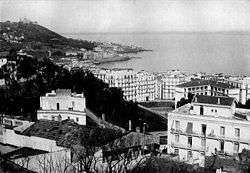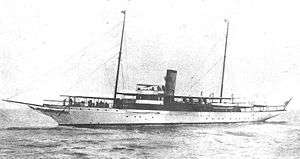Action of 8 May 1918
| ||||||||||||||||||||||||||||||||
The Action of 8 May 1918 was a small naval engagement which occurred off Algiers, North Africa during World War I. In the action, an American armed yacht and a British destroyer encountered the German U-boat UB-70. Initially, the engagement was thought to be inconclusive, but later on the allied warships were credited with sinking the German submarine.
Action
On 16 April, the German U-boat UB-70—under Kapitänleutnant Johannes Remy—left her home port in Germany for the Mediterranean Sea at the end of World War I. Her mission was to conduct unrestricted submarine warfare operations against allied supply lanes, primarily against Italian merchantmen.
Little is known about the disappearance of UB-70 except that she was in operation against an allied supply convoy somewhere near Algiers, Algeria. At about 17:00 on 8 May 1918, the American armed yacht USS Lydonia—under Richard P. McCullough—and the British destroyer HMS Basilisk were steaming and protecting a convoy from Bizerte to Gibraltar when they encountered UB-70, lining up for a shot at the British merchant ship SS Ingleside.
_IWM_SP_000610.jpg)
The Central Powers submarine fired torpedoes and at least one hit the civil vessel. Ingleside burst into flames and immediately began to sink. The merchant ship was manned by an unknown number of crew, some of whom were killed or wounded, and some went down with the ship. The survivors waited for rescue on deck of their sinking ship or in the water. Ingleside went down, and by 17:35 the protecting allied warships spotted the submarine.
According to post-war accounts, either USS Lydonia or HMS Basilisk rammed the U-boat when it began to submerge and flee. A running battle ensued for fifteen minutes. The allied warships were coordinated and together dropped several well placed depth charges on the fleeing enemy submarine until a slight oil slick began to emerge.
Aftermath

After assuming they had sunk the enemy U-boat, Lydonia and Basilisk proceeded hastily to the wreck of Ingleside. The British and American vessels rescued some survivors and took them to a friendly port, probably Algiers.
At first the incident was listed as an inconclusive contact, but after the war the authorities realized that UB-70 had not been heard from for months, and the American and British vessels received honors for their victory.
The action off Africa became one of the few confirmed sinkings of a German U-boat by an American vessel during their shorter participation in the naval war. UB-70 was also the only vessel known to have been sunk by an American vessel in Mediterranean waters during the conflict.
See also
- Action of 15 October 1917
- Action of 17 November 1917
- Action of 21 May 1918
- Action of 5 September 1918
References
- NavSource Online: Lydonia (SP 700)
- This article incorporates text from the public domain Dictionary of American Naval Fighting Ships. The entry can be found here.
- USS Lydonia (SP-700), 1917-1919. Previously the civilian steam yacht Lydonia (1912)
